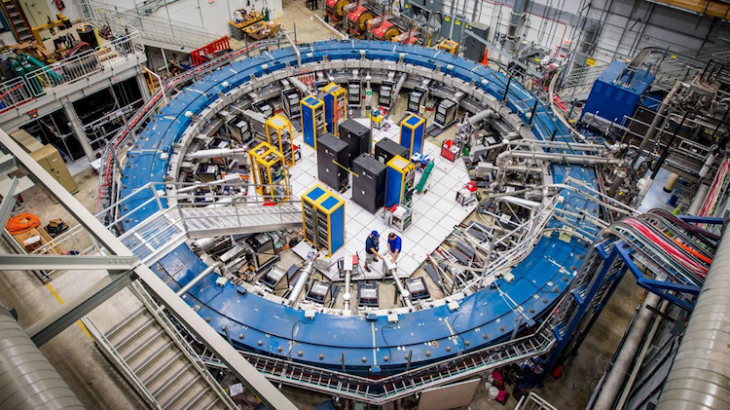Yahya Ashraf, guest contributor
As a philosopher of science, Karl Popper emphasized that a good theory is characterized by the fact that it makes a number of predictions that could be disproved or falsified by observation. Each time new experimental results agree with the predictions, the theory survives, and our confidence in it increases. But if new observations disagree, we must abandon it.
The Standard Model of Particle Physics
The Standard Model of Particle Physics (SMPP) is a theory that describes three of the four known fundamental forces in the universe (electromagnetism, weak interaction, and strong interaction). It does not describe gravity. It also classifies all known elementary particles. It is the most widely accepted physics model because it predicts the observations made at the world’s particle accelerators. Out of all the predictions made by SMPP, one of the most significant may be the anomalous magnetic dipole moment of a particle or how particles with an electric charge interact within a magnetic field.
This short video explains the Standard Model:
Muons
What exactly are muons? Muons are like the heavier cousins of electrons. They are about two hundred times heavier than electrons and, because of their weight, they become unstable and decay into lighter particles. This is the reason why muons don’t play the same roles as electrons do in atoms even though they have the same charge and spin. According to the SMPP, the electromagnetic magnetic field should make the muons wobble, somewhat like a little compass needle, at a predictable rate.
The Muon g-2 Experiment
Scientists all over the world are currently engrossed in the quest for a unifying theory that will bring together all the laws of physics. To find the path forward, we need to identify the loose threads or anomalies in our theories that might lead us to a deeper understanding of the physics underlying our universe. One thread begging to be tugged is the anomalous magnetic dipole moment of the muon. The Muon g-2 Experiment at Fermilab sought to pull that thread and the results were astonishing.
Fermilab, located in Illinois, used its powerful accelerators to explore the interactions of short-lived particles known as muons with a strong magnetic field in ‘empty’ space. They then studied the interaction of the muons with the magnetic field to find anomalies. A nice way to imagine this is to think of each muon as a small-scaled analog clock. As the particle moves around the magnet, its hour hand moves at a rate predicted by the theory. When the muon’s time is up, it decays into a positron that is emitted in the direction of the hour hand which corresponds to the muon’s spin, a quantum property that determines the direction of muon decay. But if that hand turns at a rate different from theory – say, a tick too fast – the positron decay will end up pointing in a slightly different direction. When we detect enough deviating positrons, the results are considered anomalous.
Physicists at Fermilab detected such an anomaly. More than 200 participating physicists reported that the muons wobbled at a slightly higher rate than predicted. The newly updated experimental value for muons deviates from theory by only a minuscule value (0.00000000251). But even this tiny amount can shake particle physics. The anomaly for the Muon g-2 Experiment is 4.1 sigma, meaning it is more than 4 standard deviations from the mean. To put it simply, there is a probability of 1 in 40,000 that the results of the experiments are due to some statistical fluke.
If these results are confirmed, it might be the biggest physics discovery of the decade. The anomaly in the data may indicate that there are other fundamental particles interacting with the electromagnetic field. These particles are created and destroyed very rapidly within the vacuum causing inconsistency in the data Currently, we have no idea what these particles are and what forces are associated with them but eventually, they may fill in some of the gaps in the SMPP.
What happens next?
What if there is actually new physics behind these results? How can we learn more about it? We will need new tools like the proposed International Linear Collider or the High-Luminosity Large Hadron Collider. There is also a surge in interest in a muon collider, which many researchers predict would guarantee their ability to determine the properties of the unknown particles or forces affecting the muon. These particle colliders are huge accelerators that propel particles close to the speed of light. The accelerated particles eventually interact with one another. By studying these collisions, physicists may be able to answer fundamental questions like: what are dark matter and dark energy? Does supersymmetry exist?
Many Canadian physicists like Nikolina Ilic are involved in this work. This assistant professor of Experimental Particle Physics and Astrophysics at the University of Toronto is interested in exotic particles such as gravitons, heavy neutrinos, leptoquarks, and dark matter candidates. Ilic is also involved with the international project Deep Underground Neutrino Experiment (DUNE) which aims to measure new subatomic phenomena associated with neutrinos, the most abundant particles in the universe. Her research may shed light on the anomaly observed in the Muon g-2 Experiment.
~
Whether or not Fermilab has discovered a new avenue for physics research remains to be seen. In the future, more data and improved theoretical calculations will tell the tale. But this discovery has excited the physics community. One day, these results might help us to better understand the fundamental laws of the universe and lead us to a Unified Theory of Everything.
~




